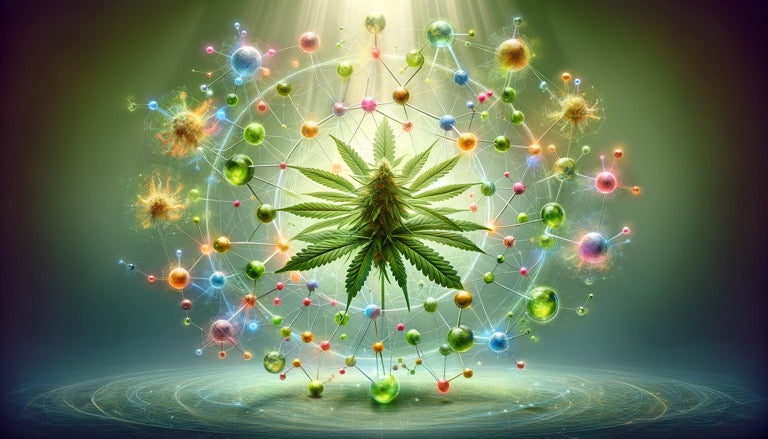Entourage Effect: Unraveling the Synergy of Cannabis Compounds
The entourage effect is an intriguing concept within the world of cannabis and therapeutic science, suggesting a complex interplay between the myriad of compounds present in the cannabis plant. This synergy could explain the nuanced effects that cannabis has on the human body, extending beyond the individual impacts of compounds like THC (tetrahydrocannabinol) and CBD (cannabidiol). This theory suggests that the whole is greater than the sum of its parts when it comes to the medicinal and psychoactive properties of cannabis.
Understanding the Basics of the Entourage Effect
The entourage effect hinges on the idea that cannabis contains several components that have the potential to work together to produce more significant effects than if they were working independently. This isn’t just about THC and CBD; it involves an extensive array of phytocannabinoids, terpenes, and flavonoids.
THC is renowned for its psychoactive properties, inducing the “high” that many associate with cannabis use. However, THC’s therapeutic potential can be hampered by side effects such as anxiety, paranoia, and cognitive impairment. Enter CBD, the non-psychoactive counterbalance to THC, which has gained acclaim for its broad therapeutic applications. CBD’s interaction with THC is one of the most cited examples of the entourage effect in action. By regulating the CB1 receptor activation by THC, CBD can mitigate the less desirable effects of THC, potentially enhancing its therapeutic efficacy.
Phytocannabinoids like CBG (cannabigerol), along with terpenes such as myrcene, limonene, and pinene, and flavonoids, also play a pivotal role. These compounds contribute not just to the aroma and flavor of cannabis but are believed to influence its therapeutic effects. Terpenes like myrcene and linalool have relaxing properties, while pinene and limonene could offer a combination of relaxation and stimulation, potentially benefiting conditions like ADHD.
Empirical Evidence and the Need for Research
The idea of the entourage effect is supported by various studies, including the 2010 study sponsored by GW Pharma, which showed patients experiencing less pain with a THC/CBD combination compared to THC alone. However, it’s critical to note that most of the evidence currently available is either anecdotal or derived from preliminary studies. The need for extensive, controlled research is paramount to transform this theory into a medically acknowledged phenomenon.
Critics of the entourage effect argue that there’s insufficient data to make conclusive claims about the complex interactions between cannabis compounds. While anecdotal evidence abounds, and smaller studies show promise, they emphasize the need for rigorous scientific investigation to validate these effects and understand the mechanisms at play.
The Complexity of Cannabis
Cannabis is a pharmacologically complex plant, with over a hundred different phytocannabinoids and over two hundred terpenes identified. The compounds within cannabis are thought to interact with the body’s endocannabinoid system (ECS), which plays a role in regulating various physiological processes, including pain, mood, appetite, and memory. The ECS consists of cannabinoid receptors, endogenous cannabinoids (endocannabinoids), and enzymes responsible for the synthesis and degradation of endocannabinoids.
When phytocannabinoids like THC and CBD enter the body, they interact with the ECS in complex ways. THC binds to cannabinoid receptors, especially CB1 receptors in the central nervous system, triggering the classic psychoactive effects. CBD, while also interacting with the ECS, does not bind to the CB1 receptor in the same way as THC, acting more as a modulator of the receptor’s activity.
Terpenes and flavonoids are not just bystanders in this interaction. For instance, beta-caryophyllene, a common terpene in cannabis, also interacts with CB2 receptors, which are primarily found in the immune system, suggesting a role in inflammation and pain regulation.
Potential Implications and Future Products
The acceptance and understanding of the entourage effect could revolutionize cannabis-based therapies and the development of cannabinoid products. It presents the possibility of tailor-made cannabinoid profiles to target specific conditions more effectively. Imagine a future where one could walk into a dispensary and choose a cannabis product designed not just for a particular condition, but also fine-tuned to the individual’s unique biochemistry.
In the case of CBD products, recognizing the entourage effect’s potential could lead to a proliferation of full-spectrum CBD oils that retain all the natural compounds found in cannabis, as opposed to isolates which contain only CBD. Full-spectrum products are already believed by many users to be more effective due to the presence of multiple cannabis compounds, which together contribute to the entourage effect.
Moving Forward
The theory of the entourage effect opens doors to new realms of pharmacological research and potential therapeutic applications. However, its validation requires a more profound commitment to scientific scrutiny. The limited but growing body of research supporting the entourage effect paves the way for a future where we not only understand the individual effects of each cannabinoid, terpene, and flavonoid but also how they interact in synergy.


